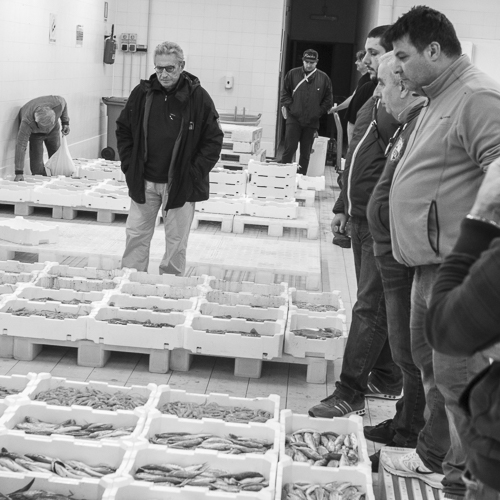Having arrived at the port of the town of Santo Stefano at sunset, we could see fishermen’s ships moored to the dock and fishermen who were sorting and sprinkling the day’s catch at the stern of the ships. The fish was sorted in 3 classes: first, second and third according to species, weight and various other characteristics. When everything was ready, the fish was brought in white styrofoam boxes filled with ice and brought by car to a large building where an auction would take place.
The contents of the boxes vary from fish like mackerel and mullet, more or less mixed (considered as a delicacy for those who like an Italian dish, which is called «fritto misto». As noted here, it consists of a mixture of cod, mullet, sole, Mediterranean scaldfish, while small fry of anchovies, rock goby and picarel may also be included; other species include giant, red shrimp of prime quality, scampi and musky octopus, all of which is put in rows of white boxes on the top of pallets placed on the floor of a big hall. After a pallet had been filled with boxes full of seafood, an auctioneer assessed the maximum price of the seafood according to species of prime quality and the minimum price determined by the same species of the lowest quality. In addition to the auctioneer, the pallet was surrounded by buyers coming from far and wide in Italy, getting ready to make their offers. The buyers buy the seafood wholesale and they sell their goods to retailers, restaurants, fishmongers, etc.
All the time people were talking loudly, even shouting and gesticulating while the seafood, which was placed in three rows on each pallet, gradually was bought by the highest bidder. The contrast with the Fish central in Oslo, Norway could hardly have been greater. There, workers were just collecting seafood according to customers’ orders, while no buyers were present.
After a successful purchase, workers would cover the fish with ice, package everything in adhesive plastic, make a label with the name of the buyer, the date, the weight and other data on a computer, print it and attach it to the package. Apparently, this is necessary to guarantee that what the wholesalers will be offering to buyers, located at various destinations and markets in Italy, is genuine, .
During the auction, the auctioneer tried naturally to obtain as high a price as possible, but when he couldn’t get the minimum price he asked for, the corresponding crates were taken off the pallet and put on another one. When the auction was finished, the crates would be packaged as described above. The remaining seafood would be sold at local markets, restaurants, fishmongers and even to local people.
Since fish needs to be consumed shortly after having been caught, everything is done efficiently, setting strict requirements to the fishermen, the auctioneer, the wholesalers and the workers who make the auction possible.

